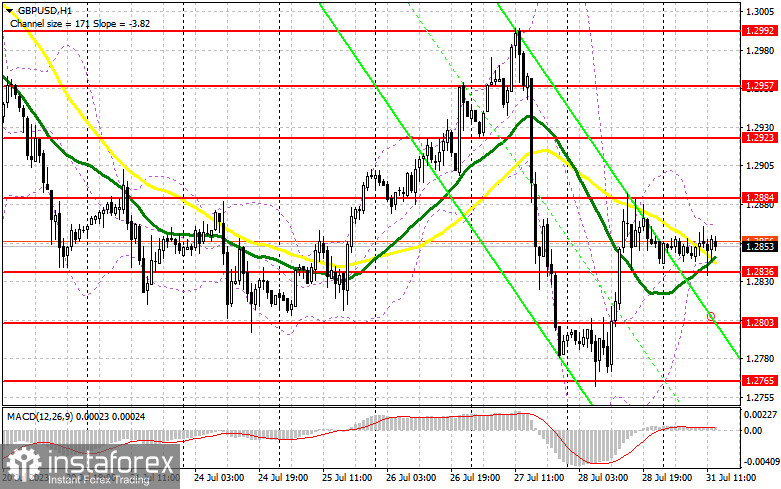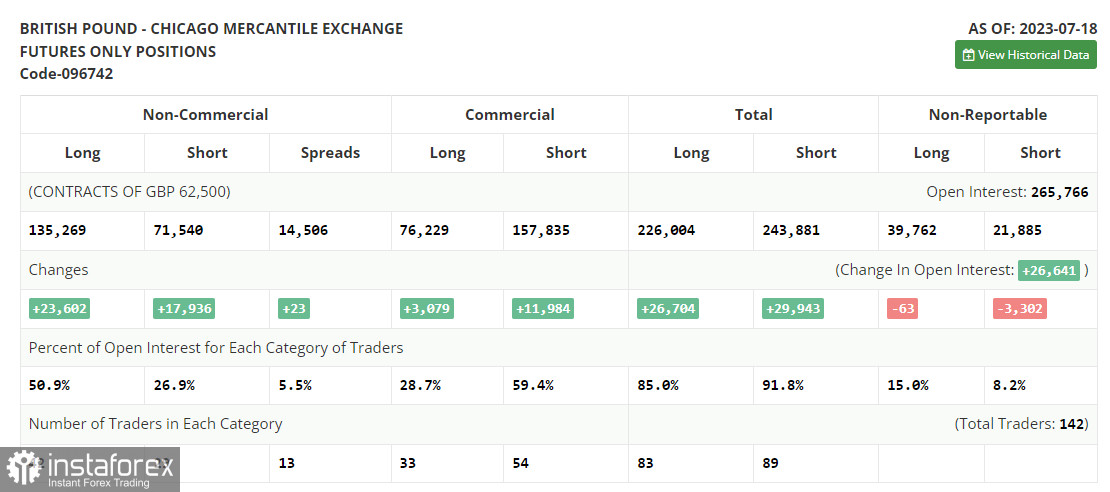In my morning forecast, I emphasized the significance of the level of 1.2836 and recommended using it as a basis for entry decisions. Let's now examine the 5-minute chart to understand what unfolded. A decline and subsequent formation of a false breakout generated a signal to initiate long positions, leading to a 20-point upward movement. The technical outlook remained unchanged for the second half of the day.

To consider long positions on GBP/USD:
As long as trading stays above 1.2836, the potential for further bullish momentum toward the new weekly high around 1.2884 exists. Weak data from the Chicago PMI, scheduled for release during the American session, might support this scenario. However, in a strong report, bears may attempt to breach the 1.2836 level again. Therefore, I will only act after observing a false breakout like the one discussed earlier. This would provide a suitable entry point for long positions, capable of propelling GBP/USD toward the nearest resistance at 1.2884. A breakout and consolidation above this range might trigger an ascending correction following the recent decline, targeting 1.2923. The ultimate target remains the resistance at 1.2957, where I recommend taking profits.
In the scenario of a decline to 1.2836 and a lack of buyers in the second half of the day (given that this level was already tested earlier today), pressure on the pound could intensify. In such a case, I would only consider opening long positions after defending the next area at 1.2803, including a false breakout at that level. I plan to buy GBP/USD immediately after a rebound from last week's low at 1.2765, aiming for a 30-35 point correction within the day.
To consider short positions on GBP/USD:
The bears attempted to breach the level of 1.2836, but their efforts were unsuccessful. An upward correction may continue because today is the last day of the month. For this reason, I won't rush into selling and will postpone such actions until the resistance at 1.2884 is protected. If the pair rises in the second half of the day, accompanied by weak Chicago PMI data, a false breakout at this level would present an excellent selling signal, expecting a new decline targeting the nearest support at 1.2836. A breakout and subsequent retest from below to above this range would substantially blow buyers' positions, potentially leading to a larger drop in GBP/USD towards 1.2803, where buyers may become active. The ultimate target remains low from last week, at 1.2765, where I would take profits.

In the scenario of GBP/USD growth and the absence of activity at 1.2884, bulls will have an opportunity to build a further upward correction at the beginning of the following week. In such a case, I will postpone selling until the resistance at 1.2923 is tested. A false breakout at that level would be an entry point for short positions. If there is no downward movement at that level, I plan to sell GBP/USD right after a rebound from 1.2957 but only expect a downward correction of 30–35 points within the day.
The COT report (Commitment of Traders) for July 18 showed a significant increase in both long and short positions. Traders started returning to the market after the release of fundamental statistics that indicated a relatively stable condition of the British economy, gradually adapting to high-interest rates. The sharp decline in inflation in the USA led to a rise in the pound. However, the pound's overbought condition and the central bank's stringent policies raised concerns about potential future issues in the UK labor and housing markets, which sellers capitalized on by increasing short positions whenever possible, as evident in the COT report. Recent PMI reports also indicated growing concerns. This week, the Federal Reserve will hold a meeting, and if they announce the end of the rate hike cycle, the pound may rise again. The optimal strategy remains to buy the pound on declines. The latest COT report stated that long non-commercial positions increased by 23,602 to 135,269, while short non-commercial positions rose by 17,936 to 71,540. This resulted in another increase in the non-commercial net position to 63,729 from 58,063 the previous week. The weekly closing price rose to 1.3049 from 1.2932.

Indicator signals:
Moving averages.
Trading occurs around the 30-day and 50-day moving averages, indicating market uncertainty.
Note: The author considers the period and prices of moving averages on the hourly chart (H1), which differs from the general definition of classical daily moving averages on the daily chart (D1).
Bollinger Bands:
In the event of a decline, the lower boundary of the indicator, around 1.2840, will act as support.
Description of indicators:
• Moving average (determines the current trend by smoothing volatility and noise). Period 50. Marked in yellow on the chart.
• Moving average (determines the current trend by smoothing volatility and noise). Period 30. Marked in green on the chart.
• MACD indicator (Moving Average Convergence/Divergence - measures the convergence/divergence of moving averages). Fast EMA period 12. Slow EMA period 26. SMA period 9.
• Bollinger Bands. Period 20.
• Non-commercial traders - speculators, such as individual traders, hedge funds, and large institutions, using the futures market for speculative purposes and meeting specific requirements.
• Long non-commercial positions represent the total long open positions of non-commercial traders.
• Short non-commercial positions represent the total short open position of non-commercial traders.
• The overall non-commercial net position is the difference between non-commercial traders' short and long positions.
 English
English 
 Русский
Русский Bahasa Indonesia
Bahasa Indonesia Bahasa Malay
Bahasa Malay ไทย
ไทย Español
Español Deutsch
Deutsch Български
Български Français
Français Tiếng Việt
Tiếng Việt 中文
中文 বাংলা
বাংলা हिन्दी
हिन्दी Čeština
Čeština Українська
Українська Română
Română

